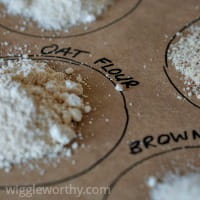Sugar Alternatives For Dogs
Safe, healthy sugar alternatives are perfect for your dog treat recipes.
Sometimes dogs like a touch of sweetness to their treats in the same way that most humans do. Sugar isn't healthy for our dogs in the same way as it's unhealthy for us, and can contribute to weight gain (and obesity), diabetes, dental problems and more.
While a little sugar occasionally won't harm a healthy dog, there are loads of other options that can add sweetness to your homemade treats.
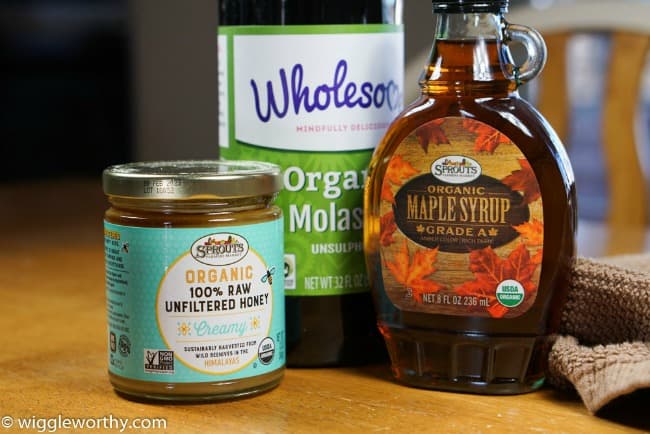
This page features healthy options you can use instead of sugar in your dog treats.
As an added bonus most of these taste even better than cane sugar and also have nutritional value.
Good choices to replace sugar in dog treat recipes include:
Not-so-good choices include:
- Brown Rice Syrup
- Cane Sugar
- Corn Syrup
- Aspertame (Nutrasweet), Saccharin (Sweet 'n Low), Sucralose (Splenda)
- Agave Nectar
Warning...
There is one sugar substitute which is highly toxic to dogs, and that is Xylitol. Never add xylitol to food/treats intended for your dog and avoid food stuffs and other products which contain it.
Xylitol can be found in some peanut butters, and other nut butters, as well as in yogurts, candies and other products.
Some brands now list Xylitol as Birch Sugar on the ingredients list. While it may be a different name, it's the same deadly dangerous ingredient!
Many dog treat recipes include sugar as an ingredient, and of course you can use sugar in your recipes if you want to, but a little goes a long way.
If I do use sugar I prefer it to be brown sugar, but as that gets hard really fast once opened, I like to use a variety of ways to keep my brown sugar soft (or soften it fast if I've forgotten to be prepared!).
Obviously it's important to be careful when using sugar, or any type of sugar alternative, for dogs with Type I ( the most common in dogs) or Type II diabetes.
Good Sugar Alternatives for Dog Treat Recipes
Here are the healthiest, most nutritious, and most natural sugar substitutes that you can use to create dog treats of all kinds:
Barley Malt Syrup
Barley malt syrup is made from sprouted barley malt and is a natural sweetener.
It is a good source of soluble fiber which helps make this syrup fall somewhere around the middle on the glycemic index (which measures how quickly blood sugar rises in response to ingesting a certain food).

Malt has traditionally been used in livestock feed, and pet food, because of it's nutritional value.
Barley malt syrup is a good source of vitamins (especially B vitamins), amino acids, enzymes, antioxidants, is a source of protein, and also acts as a prebiotic supporting digestive health.
Malt has a fairly distinctive flavor and is significantly less sweet than sugar, somewhere between one third and one half as sweet in fact.
Your dog will NOT mind this, but he will enjoy the malt flavor. Don't add extra barley malt syrup in an attempt to increase the sweetness factor because like any sugar too much is not a good thing!
Most homemade dog treat recipes don't contain more than a couple of tablespoons (or even teaspoons) of sugar.
To replace sugar with barley malt syrup you can make a like-for-like substitution in terms of measurements ie. 1 tbsp of sugar can be replaced with 1 tbsp of barley malt syrup.
A good quality barley malt syrup is not necessarily easy to find in many grocery stores, look for organic whenever possible. Eden Foods Organic Barley Malt syrup is the one I prefer to use and although it's often difficult to find in grocery stores it's available online from amazon, iherb and other suppliers.
Barley Malt Syrup has a Glycemic Index of between 42 and 45
Blackstrap Molasses
Blackstrap Molasses is a natural, nutrient-dense sweetener which is perfect for using in your homemade dog treat recipes. In the UK it's know as treacle.
Like honey, blackstrap molasses is considered to be a superfood sweetener and contains a powerful blend vitamins, minerals, antioxidants and other healthy nutrients including Iron, B vitamins, calcium, maganese, potassium, selenium, copper and zinc.
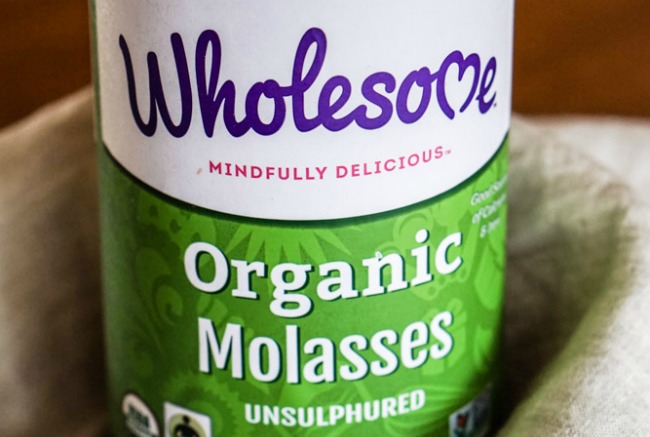
Blackstrap molasses is a by-product of cane sugar processing, it's what's left after the sugar cane has been processed (boiled) and the crystallized sugar has been removed three consecutive times. It has the lowest sucrose content of any type of molasses and is the most nutritionally dense.
Sugar Cane is Triple-Boiled to make Blackstrap Molasses
The result of the first sugar cane boil is called 'first molasses' and is lighter colored with a higher sugar content.
The second boil produces 'second molasses' which is slightly darker (due to the caramelization of the sugar as it boils).
The third boil is what produces the thick, dark concentrated liquid known as blackstrap molasses.
Molasses can also be divided into two types... Sulphured Molasses and Unsulphured Molasses.
Sulphured molasses is made from processing young, raw sugar cane which hasn't been allowed to ripen before being harvested. In this case, sulfur dioxide is used during processing.
Unsulphured molasses is made from mature sugar cane which has fully ripened naturally before being processed.
Blackstrap molasses can be either sulphured or unsulphured.
There is currently no scientific evidence to prove that sulphured molasses is unsafe, but as sulfur dioxide has been linked to an allergic response to sulfites in food, and that sulfur dioxide istself is a pollutant, I personally prefer to use unsulphured molasses for all my recipes (I also choose organic, unsulphured version, but the organic part is optional!).
Because most of the sucrose has been removed from the liquid which becomes blackstrap molasses, it's actually not supersweet, perhaps about half as sweet as sugar, if that.
One or two tablespoons of unsulphured blackstrap molasses can replace the sugar in most dog treat recipes.
Blackstrap Molasses has a Glycemic Index of 55
Carob
Carob is a chocolate-y flavored sweetener which is produced from the seeds (beans) within the pods of the Carob tree which is native to the Mediterranean region.
Use carob powder as a sugar or chocolate alternative for dogs to add both a hint of sweetness and a delicious chocolate-y taste to your dog treats.
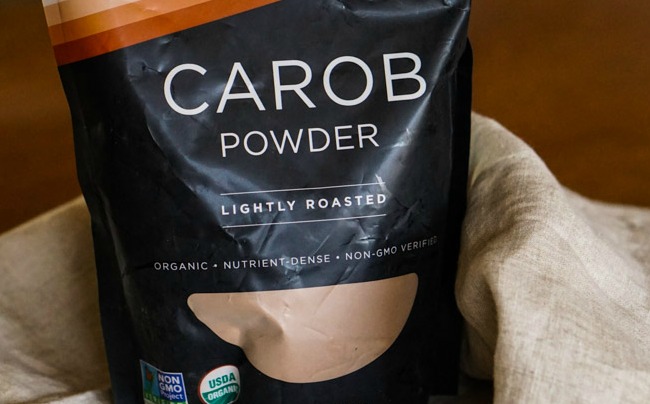
Chocolate is extremely poisonous to dogs because of the theobromine it contains. Chocolate also contains caffeine which is dangerous for our dogs. NEVER use chocolate in any treat or food that you give your dog.
Carob is theobromine and caffeine free. It's nutrient rich, and a source of vitamins and minerals including vitamins A, B and D, calcium, iron, potassium, manganese, pectin and fiber.
All of this makes carob another superfood sweetener.
You can replace the sugar your recipe calls for with an equal measure of carob powder, or replace cocoa powder the same way.
Carob chips can be used to make dog-friendly carob-chip cookies. Not all carob chips get melt-y and gooey the way chocolate chips do when baking, but some do. They won't keep that softness once cooled, but they still taste delicious and your dog will enjoy them as much as you enjoy your chocolate chips!
You can also use carob chips to make a faux-chocolate glaze or icing for your dog treat creations. Carob chips will melt in a double boiler and you can add a little canola or coconut oil to make the end result look smooth and shiny.
Carob has Glycemic Index of around 40
Check out this page to learn more about carob and links to some dog treat recipes using carob powder or carob chips.
Coconut Sugar
Coconut sugar is the final result of a process of evaporation using the nectar from coconut palm flowers.
Pure coconut sugar contains an array of nutrients including vitamin C, calcium, iron, zinc and antioxidants. It also has some fiber.
Due to it's low glycemic index this is a good choice for diabetics or overweight dogs.
It looks a lot like regular brown sugar, but tastes a little less sweet.
Coconut sugar is one of the simplest sugar alternatives for dogs when it comes to substitution in recipes. Simply replace the sugar your recipe calls for with an equal amount of coconut sugar.
Coconut sugar has a Glycemic Index of 35
Coconut Nectar (aka Coconut Syrup)
Coconut nectar is made from the nectar of coconut palm blossoms, rather than the coconut itself.
The nectar is collected and then created using an evaporation process. If the process is repeated, or left to continue, the end result would be crystallized coconut sugar.
It's another sugar alternative for dogs that contains a range of vitamins, minerals and other nutrients including B vitamins, potassium, iron, magnesium, zinc and amino acids.
Coconut nectar tastes a little like buttery caramel and is sweet enough to be used as a replacement for maple syrup on pancakes, that means you only need to add a little to your recipes to get the sweetness you want.
You can replace any other natural liquid sweetener such as maple syrup, or blackstrap molasses with coconut nectar in a one-for-one ratio.
If you're replacing sugar then try adding half the amount of coconut nectar and remember this will change the consistency of the dough/batter (eg. if you need to add 3 tbsp of sugar, add 1 1/2 tbsp of coconut nectar).
Coconut Nectar isn't as readily available as some of the other sugar alternatives on this page and it's also one of the most expensive.
You may find it online more readily than in the grocery store. I get it from pure organic coconut nectar from Amazon. Read the label of the nectar you choose to be sure it's pure and has no other sugars added. Some coconut 'syrups' contain high-fructose corn syrup.
Coconut Nectar has a Glycemic Index of 35
Honey
Honey has been used to sweeten food and drinks for centuries. It's a safe and nutritious sugar alternative.
Honey is a natural product which, in it's raw straight-from-the-hive form contains vitamins, minerals, antioxidants and enzymes, including B vitamins, iron, calcium, zinc, potassium, phosphorus, magnesium and manganese.
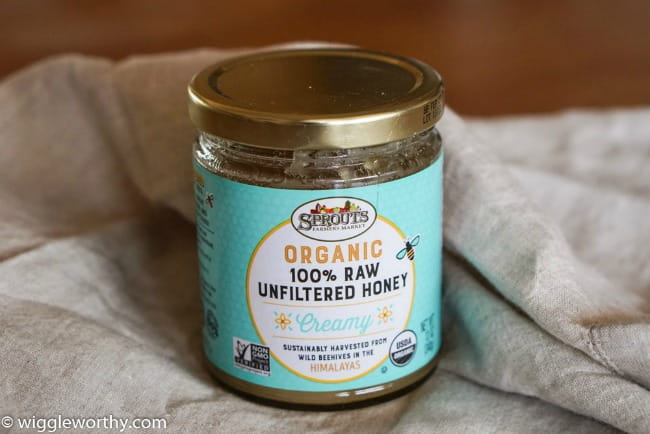
Honey also has antiviral and antibacterial properties and medical research indicates that locally-sourced raw honey can help reduce allergy symptoms related to pollen and seasonal irritants. Raw honey can also soothe the digestive system.
You can substitute honey for sugar by using somewhere between 1/4 and 1/2 the amount of honey as you would sugar.
For recipes your honey needs to be in a liquid state. You can achieve this by warming raw or crystallized honey.
For example:
- If your recipe calls for 1/4 cup of sugar, add 1/8 cup of honey, or less.
- If it calls for two tsps of sugar, add between 1/2 and one tsp of honey
Honey has a Glycemic Index of 50
Raw Honey v Processed (ie 'regular') Honey
You're likely to see both raw and processed honey on your grocery store shelves. So what's the difference and which should you use?
Raw honey is in it's natural state , contains vitamins, minerals, antioxidants and enzymes, as well as trace amounts of pollen and bee dust. This makes it a superfood sweetener.
Regular honey has been processed by being heated to a temperature above 70C, this is also called pasteurization. Pasteurized honey destroys yeast cells and stops the honey from fermenting, this gives it a longer shelf-life. Processed honey is also often filtered to produce a clearer liquid.
Organic honey can be either raw or processed/pasteurized. Organic honey produced in the USA is USDA guaranteed not to have had any contact with pesticides or chemicals (that includes both flowers and bees).
Pasteurizing honey destroys the vitamins, minerals, anti-oxidants and enzymes. It also removes the pollen and bee dust, and eradicates the antibacterial and antiviral properties. Regular honey may LOOK clearer, cleaner and last a little longer in your cupboard, but it has virtually none of the health benefits of raw honey. Regular honey may also contain small amounts of other types of sweetener, so always check the labels to be sure that what you have is pure honey, processed or raw.
All types of honey will add the sweetness that you want to your recipes, but only raw honey can also add a dose of healthy nutrients as well. I always buy raw, organic honey for the humans, and dogs, in my family.
If you want only the best, and most nutritious, honey available for your family (and your dog treats!) check out Manuka Honey, which is made from pollen which comes from the Manuka tree which is native to New Zealand. It contains a unique enzyme called Methylglyoxal which has very powerful antibacterial properties making Manuka honey the healthiest raw honey on the market.
Veterinary advice is not to give raw honey to puppies under one year old, because it may contain fungal spores that could make them sick as their immune system isn't fully developed.
Maple Syrup
We're all familiar with the delicious taste of Maple Syrup and dogs enjoy it about as much as we do.
Pure maple syrup is a good source of B vitamins, manganese, zinc and other nutrients including unique anti-inflammatory compounds.
There are two primary categories of maple syrup, A and C (no, there's no B!). Grade A is lighter in color and has a sweeter flavor, Grad C is darker, thicker and stronger flavored. Either works great in dog treat recipes.
As with many of the natural liquid sugar alternatives for dogs featured on this page, a little goes a long way!
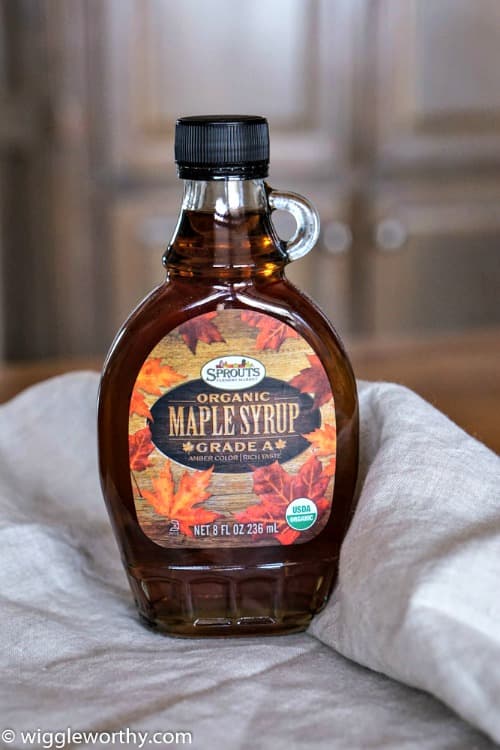
Maple syrup is very sweet, and that sweetness mostly comes from the sucrose (sugar) it contains. This means it's not a good choice for dogs with diabetes.
Don't confuse pure maple syrup with syrups labelled 'pancake' syrup or 'breakfast syrup'. These often contain high fructose corn syrup with added flavoring. Always check the label to be sure what you're buying is pure maple syrup and nothing else.
Maple Syrup has a Glycemic Index of 54
Replacing a dry ingredient with a liquid one
When you replace a dry ingredient with a liquid one (ie replacing sugar with a syrup) it obviously affects the consistency of the dough/batter.
So, if your recipe calls for sugar or another dry sweetener and you want to replace it with a syrup you might want to reduce any added liquid (ie milk/water) to begin with and until you see how the dough is shaping up.
Stevia
Although Stevia may seem to be a relatively new sweetener, it's actually been used in some parts of the world for hundreds of years.
Stevia is made from the leaves of the Stevia plant, so is also a natural sugar alternative.
It's non-toxic to dogs, is low calorie, gets a '0' on the glycemic index and is about 200 to 300 times as sweet as sugar.
The best type of stevia to use is Green Stevia which is less processed than the white variety and contains a number of nutrients including vitamin C, iron, calcium, beta-carotene, zinc and magnesium.
One downside to stevia is that it leaves an aftertaste. Personally I don't like it and don't use it myself, your dogs may or may not notice or care!
Substitute stevia for sugar in a recipe by adding 1/3 to 1/2 tsp of stevia in place of 1 cup of sugar. It's more difficult to measure stevia in recipes where only a little sugar is called for in the first place.
However, if you're making a recipe which calls for, say, one cup of sugar (and this is much more likely to happen in recipes designed for people, not dogs!) then you need to replace the volume left by the loss of the bulk of almost one whole cup of sugar. This makes using stevia for baking when the recipe calls for sugar a bit tricky, and you may be better using a different alternative.
Stevia has a Glycemic Index of 0
How Many Daily Treats Are Okay?
Veterinarians recommend that dog treats shouldn't make up more than 10% of your dog's daily diet.
To be more precise, they shouldn't exceed 10% of your dog's calorie intake per day.
Obviously it takes some time, and more than a little math, to figure out how many calories your dog eats in a day, and how many treats are okay. If you aren't able to get to an exact figure, don't worry too much, as long as your dog is in good health, and at a healthy weight, a few treats aren't going to cause problems.
But remember to take into account the size, and ingredients in your dog treats.
If they're tiny bite sized treats, then half a dozen may be just fine. If you're giving your pup a cookie the size of his paw, one is more than enough. You can break up large treats and dole them out a piece at a time.
Healthy ingredients and low-or-no sugar recipes are much less of a problem than store bought high fat, high sugar treats packed with chemicals and other questionable ingredients. A lot of this is just common sense!
Not-so-good Sugar Alternatives for Dogs
There are lots of sugar substitutes that can be used in dog treats. Some, like the ones listed above have nutritional value and are better than pure sugar (sucrose).
Others are high in sucrose and have very little nutritional value. Still others are sugar-free but still have no nutritional value. Neither of these options are likely to be your first choice for adding to homemade dog treat recipes.
Dogs who have no issues with weight gain or obesity and who are otherwise healthy and active aren't likely to have any negative effects of eating treats with a little sugar, or sugar-free sweetener. But MODERATION is key.
The only sugar alternative you absolutely have to avoid is Xylitol due to it's extreme toxicity in dogs.
Brown Rice Syrup
Brown rice syrup is made from whole grain rice which is boiled and then processed using enzymes to produce sugars.
Brown rice syrup has a toffee-ish flavor and is fairly sweet. It also has a high GI value due to the fact that it's pretty much pure glucose. Brown rice syrup also contains trace amounts of certain minerals but barely.
There is also a safety concern with brown rice syrup, and that concerns the fact that rice can contain measurable levels of arsenic which also can be found in rice syrups and other products. The full health impact of these levels of arsenic are not known yet, but arsenic can cause a host of health problems in people and pets, a it's a poison after all.
So, brown rice syrup will add sweetness to your recipes, but nothing else.
To substitute brown rice syrup for sugar in your recipes use about one-fourth extra syrup (ie for four tsp of sugar, and five tsp of brown rice syrup).
You may need to adjust the ingredients for consistency as mentioned earlier on this page.
Brown Rice Syrup has a Glycemic Index of 98
Cane Sugar ('Regular' Sugar)
Regular sugar (whether it's white or brown) is simply sucrose and has no nutritional value at all, and isn't healthy for anyone, or any dog.
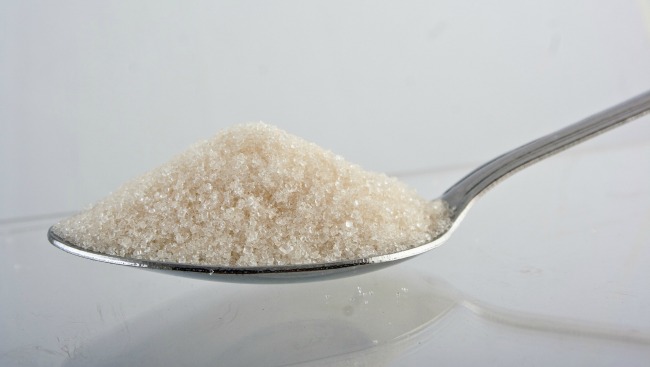
It can contribute to obesity, heart disease, cancer, inflammation and auto-immune problems in our dogs.
There are several good, natural, nutritious sugar alternatives for dogs listed above if you want to add a touch of sweetness to your dog's treats.
Sugar has a Glycemic Index of 68
Corn Syrup
There are two types of corn syrup, the 'regular' variety and 'high-fructose' corn syrup (HFCS).
Regular corn syrup is pure glucose. High-fructose corn syrup is the result of further processing which then produces a blend of glucose and fructose.
HFCS was originally produced as a low-cost alternative to sugar, it also has a lower glycemic index than regular corn syrup.
One concern over high fructose corn syrup is that it's more difficult for the liver to metabolize fructose than glucose or sucrose.
If the body intakes too much fructose it can lead to additional health issues (above and beyond the ones posed by sugar in general) such as fatty liver disease, kidney disease, accelerated aging and more.
Although a handful of treats containing high fructose corn syrup isn't likely to cause your dog any significant health issues, it's important to know that many dog foods already contain HFCS. This intake is then compounded if it's added to his treats.
Check the ingredients label before you buy as some products simply labelled 'corn syrup' actually add HFCS but don't make that clear on the front.
If you want to use corn syrup as a sweetener in your dog treat recipes, I'd suggest using Karo syrup which contains no HFCS.
Corn syrup has a Glycemic Index of 100
High fructose Corn Syrup has a Glycemic Index of between 56 and 62
Aspertame, Saccharin and Sucralose
Although these sugar-free sweeteners aren't dangerous to dogs (unless they ingest huge amounts), it's not recommended that you give it to your pooch or add it to homemade goods intended for the canine family members.
These types of artificial sweeteners can sometimes cause loose stools or diarrhea in dogs, especially if they ingest more than a few milligrams.
Agave Nectar
Agave nectar (or syrup) which comes from the root of the agave plant is not really a natural sweetener because it's processed chemically and is highly refined, ending up as pretty much pure fructose.
Agave nectar that is made this way actually has a more intense concentration of fructose than high fructose corn syrup does, and along with that come the concerns over the dangers and health risks associated with high fructose intake.
There is another type of Agave nectar/syrup which is made from the sap of the agave plant, this is a natural sweetener with a low glycemic index, but it still contains a high concentration of fructose.
Both types of agave nectar are gluten free and vegan, and combine that with it's low GI value and it looks like a healthy sugar alternative, but it's not. It's basically a highly process sugar with no nutritional value.
If you still want to replace sugar in a recipe with agave nectar, add the nectar at 1/3 less than the sugar called for and also reduce the liquid by approx. 1/8th
Agave Nectar from the plant root has a Glycemic Index of between 70 & 90
Agave Nectar from the plant sap has a Glycemic Index between 20 & 30
Xylitol
Of all the sweeteners which are not suitable for dogs, Xylitol stands head and shoulders above the rest when it comes to being dangerous.
In fact, Xylitol is deadly for dogs. Causing a steep decline in blood sugar and irreversible liver damage.
NEVER add Xylitol to your homemade dog treats and avoid any ingredients which contain it as a sweetener.
Common food items which may contain Xylitol (in certain brands) include:
- Nut butters (including peanut butter)
- Yogurts
- Pudding
- Baking mixes
- Syrups
- Ketchup/Barbecue Sauce
- Jellies or Jams
Xylitol can also found in chewing gum, breath mints, hard candies, protein bars, flavored water, protein powders and mixes, medications, vitamins, toothpaste (and other dental products such as mouthwash) and more. Check out this comprehensive list of products which contain xylitol from preventativevet.com
Xylitol Poisoning
Symptoms of Xylitol poisoning related to low blood sugar can include weakness, shaking, collapse or seizures. These usually show up quickly, within about twelve hours.
Signs of liver damage include reduced appetite, lethargy, vomiting, diarrhea, yellowing of skin, gums, eyes. These symptoms may take two, or three, days to develop but by this point irreversible damage may have been done.
If your dog has eaten anything containing Xylitol, don't 'wait-and-see', get him immediate veterinary help so he has a chance of recovery.
Sweeten your treat recipes without sweeteners!
Instead of using sugars, syrups or sweeteners, the sweet flavor of your dog treats can come from the ingredients themselves instead.
Apples, bananas, sweet potatoes, berries and pumpkin puree are all great choices for dog treat recipes where you're looking for sugar alternatives.
Dried fruit can add sweetness, but be careful which fruits you choose because some fruits are poisonous for dogs, including:
- Raisins
- Sultanas
- Currants
- Cherries
- Citrus fruits
Safe and healthy dried fruits to include in your homemade dog treat recipes include:
- Dried apricots
- Dried cranberries
- Dried pineapple (use in moderation)
- Dried mangos
About the Glycemic Index
The Glycemic Index (GI) measures how quickly glucose levels in the blood rise in response to eating a specific food. The higher the number the faster, glucose levels rise in your dog's blood, and then the steeper the 'crash' afterwards. Lower GI ratings are best for dogs with diabetes or heart problems, and are overall better for health in general.
I've added the GI values for each sugar alternative featured on this page. For your reference, sugar has a GI of 65.
You Might Also Like These pages...
- Home
- Dog Treat Ingredients
- Sugar Alternatives for Dogs
- Home
- Baking Substitutions for Dog Treat Recipes
- Sugar Alternatives for Dogs


